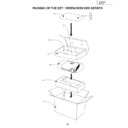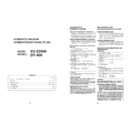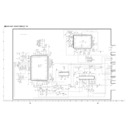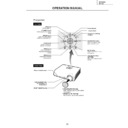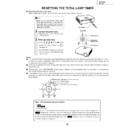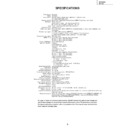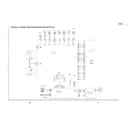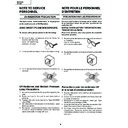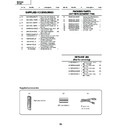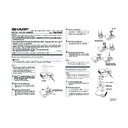Read Sharp XV-Z2000E (serv.man14) Service Manual online
27
XV-Z2000
DT-400
DT-400
ELECTRICAL ADJUSTMENT
3-2
G-Bright / G-
Contrast
(Manual or auto
adjustment)
Contrast
(Manual or auto
adjustment)
1. Group: AD
Subject: G-BRIGHT
(Black level)
G-CONTRAST
(White level)
(Black level)
G-CONTRAST
(White level)
2. Feed the window pattern
signal containing 91%
(0.64Vp-p) G signal and
0% level.
(Process/Gamma interac-
tion)
(SVGA or XGA)
Input 5 RGB input
(0.64Vp-p) G signal and
0% level.
(Process/Gamma interac-
tion)
(SVGA or XGA)
Input 5 RGB input
1. Observe the 0% window pattern chromaticity on
CA100.
2. Starting with a bit dropout screen, vary the G-
Bright setting until the bright green "y" setting
turns toward the black tone and stays there. Now
raise the setting by one point and adjust to the
point where the first bit dropout is encountered
(the setting changes over 5/1000).
turns toward the black tone and stays there. Now
raise the setting by one point and adjust to the
point where the first bit dropout is encountered
(the setting changes over 5/1000).
3. Observe the 91% G signal chromaticity on CA100.
4. Starting with a bit dropout screen, vary the R-
4. Starting with a bit dropout screen, vary the R-
Contrast setting until the bright green "y" set-
ting turns toward the black tone and stays there.
Now raise the setting by one point and adjust to
the point where the first bit dropout is encoun-
tered (the setting changes over 5/1000).
ting turns toward the black tone and stays there.
Now raise the setting by one point and adjust to
the point where the first bit dropout is encoun-
tered (the setting changes over 5/1000).
1
Initialization of
EEPROM
EEPROM
1. Turn on the power (the
lamp lights up) and warm
up the system for 15 min-
utes.
up the system for 15 min-
utes.
1. Carry out the following setting.
Using the remote controller or press S2002 to
enter the process mode, and execute SS2 on SS
menu.
enter the process mode, and execute SS2 on SS
menu.
2
Adjustment of
CW index
CW index
1. Input the gradation pat-
tern of RGB.
(SVGA60Hz or XGA)
(SVGA60Hz or XGA)
2. S e l e c t t h e f o l l o w i n g
group and subject.
Group: DLP
Subject: INDEX DELAY
Group: DLP
Subject: INDEX DELAY
1. Select subject and make adjustment so that the
lamp gradation patterns of R, G and B should be
smooth without noise.
smooth without noise.
R
G
B
3-1
R-Bright / R-
Contrast
(Manual or auto
adjustment)
Contrast
(Manual or auto
adjustment)
1. Group: AD
Subject: R-BRIGHT
(Black level)
R-CONTRAST
(White level)
(Black level)
R-CONTRAST
(White level)
2. Feed the window pattern
signal containing 91%
(0.64Vp-p) R signal and
0% level.
(Process/Gamma interac-
tion)
(SVGA or XGA)
Input 5 RGB input
(0.64Vp-p) R signal and
0% level.
(Process/Gamma interac-
tion)
(SVGA or XGA)
Input 5 RGB input
1. Observe the 0% window pattern chromaticity on
CA100.
2. Starting with a bit dropout screen, vary the R-
Bright setting until the bright red "x" setting turns
toward the black tone and stays there. Now raise
the setting by one point and adjust to the point
where the first bit dropout is encountered (the
setting changes over 5/1000).
toward the black tone and stays there. Now raise
the setting by one point and adjust to the point
where the first bit dropout is encountered (the
setting changes over 5/1000).
3. Observe the 91% R signal chromaticity on CA100.
4. Starting with a bit dropout screen, vary the R-
4. Starting with a bit dropout screen, vary the R-
Contrast setting until the bright red "x" setting
turns toward the black tone and stays there. Now
raise the setting by one point and adjust to the
point where the first bit dropout is encountered
(the setting changes over 5/1000).
turns toward the black tone and stays there. Now
raise the setting by one point and adjust to the
point where the first bit dropout is encountered
(the setting changes over 5/1000).
No.
Adjusting point
Adjusting conditions
Adjusting procedure
No.
Adjusting point
Adjusting conditions
Adjusting procedure
28
XV-Z2000
DT-400
DT-400
3-3
B-Bright / B-
Contrast
(Manual or auto
adjustment)
Contrast
(Manual or auto
adjustment)
1. Group: AD
Subject: B-BRIGHT
(Black level)
B-CONTRAST
(White level)
(Black level)
B-CONTRAST
(White level)
2. Feed the window pattern
signal containing 91%
(0.64Vp-p) B signal and
0% level.
(Process/Gamma interac-
tion)
(SVGA or XGA)
Input 5 RGB input
(0.64Vp-p) B signal and
0% level.
(Process/Gamma interac-
tion)
(SVGA or XGA)
Input 5 RGB input
1. Observe the 0% window pattern chromaticity on
CA100.
2. Starting with a bit dropout screen, vary the B-
Bright setting until the bright blue "y" setting turns
toward the black tone and stays there. Now raise
the setting by one point and adjust to the point
where the first bit dropout is encountered (the
setting changes over 5/1000).
toward the black tone and stays there. Now raise
the setting by one point and adjust to the point
where the first bit dropout is encountered (the
setting changes over 5/1000).
3. Observe the 91% G signal chromaticity on CA100.
4. Starting with a bit dropout screen, vary the B-
4. Starting with a bit dropout screen, vary the B-
Contrast setting until the bright blue "y" setting
turns toward the black tone and stays there. Now
raise the setting by one point and adjust to the
point where the first bit dropout is encountered
(the setting changes over 5/1000).
turns toward the black tone and stays there. Now
raise the setting by one point and adjust to the
point where the first bit dropout is encountered
(the setting changes over 5/1000).
4-1
DTV Bright/
Contrast Ad-
justment
Contrast Ad-
justment
1. Group: DTV
Subject:BRIGHT
(Black level)
CONTRAST
(White level)
(Black level)
CONTRAST
(White level)
1. Check the fixed value.
Contrast: 5
Bright: 55
Bright: 55
4-2
DTV R-Bright/
Contrast Ad-
justment
(Manual or auto
adjustment)
Contrast Ad-
justment
(Manual or auto
adjustment)
1. Group: DTV
Subject:R-BRIGHT
(Black level)
R-CONTRAST
(White level)
(Process/GAMMA interac-
tion Input5 Color differ-
ence input)
(Black level)
R-CONTRAST
(White level)
(Process/GAMMA interac-
tion Input5 Color differ-
ence input)
1. Observe the 0%black window pattern chroma-
ticity on CA100.
2. Starting with a bit dropout screen, vary the Bright
setting until the bright red "x" setting turns to-
ward the black tone and stays there. Now raise
the setting by one point and adjust to the point
where the first bit dropout is encountered (the
setting changes over 5/1000).
ward the black tone and stays there. Now raise
the setting by one point and adjust to the point
where the first bit dropout is encountered (the
setting changes over 5/1000).
3. Observe the 100% W window pattern chromatic-
ity on CA100.
4. Starting with a bit dropout screen, vary the Con-
trast setting until the bright red "x" setting turns
toward the black tone and stays there. Now raise
the setting by one point and adjust to the point
where the first bit dropout is encountered (the
setting changes over 5/1000).
toward the black tone and stays there. Now raise
the setting by one point and adjust to the point
where the first bit dropout is encountered (the
setting changes over 5/1000).
4-3
DTV G-Bright/
Contrast Ad-
justment
(Manual or auto
adjustment)
Contrast Ad-
justment
(Manual or auto
adjustment)
1. Group: DTV
Subject:G-BRIGHT
(Black level)
G-CONTRAST
(White level)
(Process/GAMMA interac-
tion Input5 Color differ-
ence input)
(Black level)
G-CONTRAST
(White level)
(Process/GAMMA interac-
tion Input5 Color differ-
ence input)
1. Observe the 0%black window pattern chroma-
ticity on CA100.
2. Starting with a bit dropout screen, vary the Bright
setting until the bright green "y" setting turns
toward the black tone and stays there. Now raise
the setting by one point and adjust to the point
where the first bit dropout is encountered (the
setting changes over 5/1000).
toward the black tone and stays there. Now raise
the setting by one point and adjust to the point
where the first bit dropout is encountered (the
setting changes over 5/1000).
3. Observe the 100% W window pattern chromatic-
ity on CA100.
4. Starting with a bit dropout screen, vary the Con-
trast setting until the bright green "y" setting turns
toward the black tone and stays there. Now raise
the setting by one point and adjust to the point
where the first bit dropout is encountered (the
setting changes over 5/1000).
toward the black tone and stays there. Now raise
the setting by one point and adjust to the point
where the first bit dropout is encountered (the
setting changes over 5/1000).
No.
Adjusting point
Adjusting conditions
Adjusting procedure
29
XV-Z2000
DT-400
DT-400
9
DTV Color
Saturation Level
Saturation Level
1. Group: DVD
Subject: Color
1. Check the fixed value.
Color: 8
10
Video Bright/
Contrast
Adjustment
Contrast
Adjustment
1. Group: VIDEO
Subject:BRIGHT
(Black level)
CONTRAST
(White level)
(Black level)
CONTRAST
(White level)
1. Check the fixed value.
Contrast: 5
Bright: 55
Bright: 55
8
DVD Tint
1. Check the fixed value.
Tint: 4
1. Group: DVD
Subject: Tint
7
DVD Bright/
Contrast Ad-
justment
Contrast Ad-
justment
1. Group: DVD
Subject:BRIGHT
(Black level)
CONTRAST
(White level)
(Black level)
CONTRAST
(White level)
1. Check the fixed value.
Contrast: 5
Bright: 55
Bright: 55
5
DTV Tint
1. Group: DTV
Subject: Tint
1. Check the fixed value.
Tint: 8
6
DTV Color
Saturation
Level
Saturation
Level
1. Group: DTV
Subject: Color
1. Check the fixed value.
Color: 6
12
VIDEO Color
Saturation Level
Saturation Level
1. Group: VIDEO
Subject:N-Color
P-Color
S-Color
P-Color
S-Color
1. Check the fixed values.
N-Color: 7
P-Color: 4
S-Color: 7
P-Color: 4
S-Color: 7
11
VIDEO Tint
1. Group: VIDEO
Subject:N-Tint
P-Tint
S-Tint
P-Tint
S-Tint
1. Check the fixed values.
N-Tint: 8
P-Tint: 4
S-Tint: 4
P-Tint: 4
S-Tint: 4
4-4
DTV B-Bright/
Contrast Ad-
justment
(Manual or auto
adjustment)
Contrast Ad-
justment
(Manual or auto
adjustment)
1. Group: DTV
Subject:B-BRIGHT
(Black level)
B-CONTRAST
(White level)
(Process/GAMMA interac-
tion Input5 Color differ-
ence input)
(Black level)
B-CONTRAST
(White level)
(Process/GAMMA interac-
tion Input5 Color differ-
ence input)
1. Observe the 0%black window pattern chroma-
ticity on CA100.
2. Starting with a bit dropout screen, vary the Bright
setting until the bright blue "y" setting turns to-
ward the black tone and stays there. Now raise
the setting by one point and adjust to the point
where the first bit dropout is encountered (the
setting changes over 5/1000).
ward the black tone and stays there. Now raise
the setting by one point and adjust to the point
where the first bit dropout is encountered (the
setting changes over 5/1000).
3. Observe the 100% W window pattern chromatic-
ity on CA100.
4. Starting with a bit dropout screen, vary the Con-
trast setting until the bright blue "y" setting turns
toward the black tone and stays there. Now raise
the setting by one point and adjust to the point
where the first bit dropout is encountered (the
setting changes over 5/1000).
toward the black tone and stays there. Now raise
the setting by one point and adjust to the point
where the first bit dropout is encountered (the
setting changes over 5/1000).
30
XV-Z2000
DT-400
DT-400
13
DVD White
balance
(Auto
adjustment)
balance
(Auto
adjustment)
1. Feed the component 75%
gray scale signal.
2. Group: PIXEL
Subject:R-GAIN (R)
B-GAIN (B)
Input 5 Color
difference input
B-GAIN (B)
Input 5 Color
difference input
1. Adjust the white balance by controlling R-GAIN and
B-GAIN.
(Adjust x=298 and y=319.)
(Adjust x=298 and y=319.)
1. Make the following settings.
Destination
Process adjustment Remote controller setting
Europe
SS3
Factory setting 3
North America
SS4
Factory setting 4
15
Factory setting
14
DLP voltage
adjustment
adjustment
1. Read the DLP-listed volt-
age rank.
2. Make the switch setting
corresponding to the read-
out rank.
(on the Formatter PWB)
out rank.
(on the Formatter PWB)
1. Make this adjustment when the DLP chip has been
replaced or the combination of DLP chip and
Formatter PWB has been changed.
Formatter PWB has been changed.
1. Ranking: D E
No.
Adjusting point
Adjusting conditions
Adjusting procedure
30


